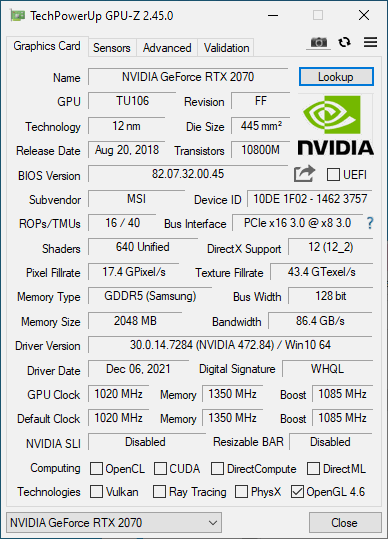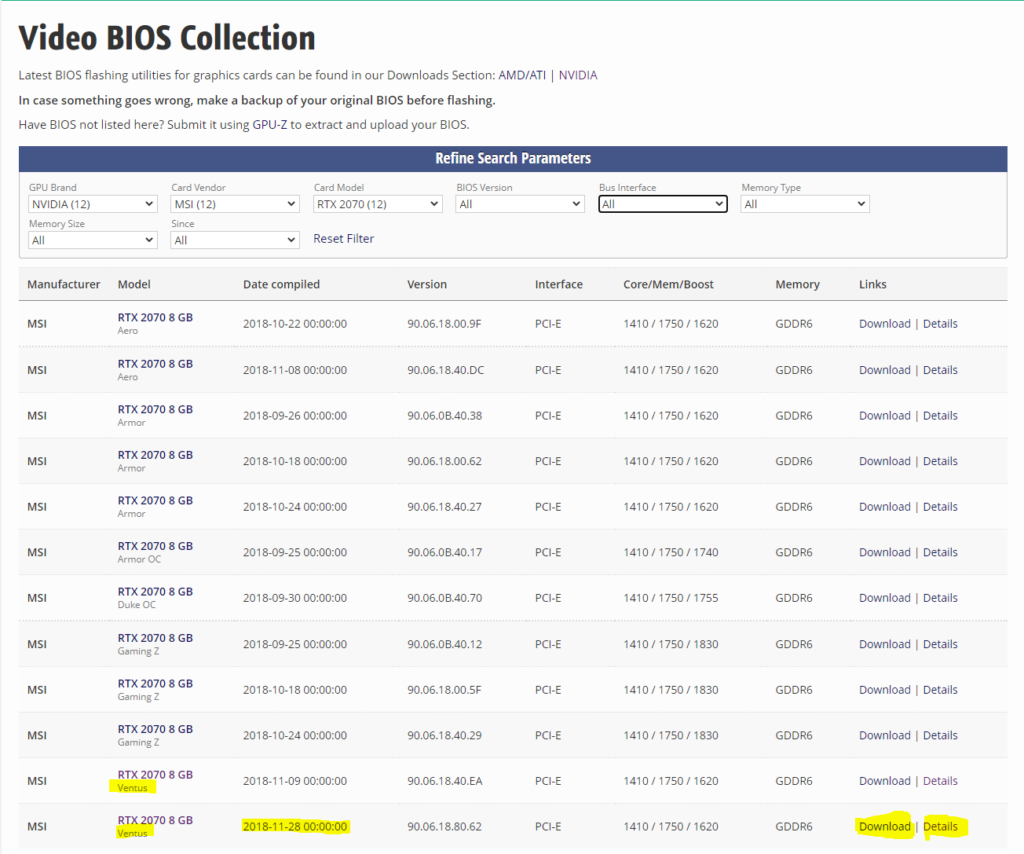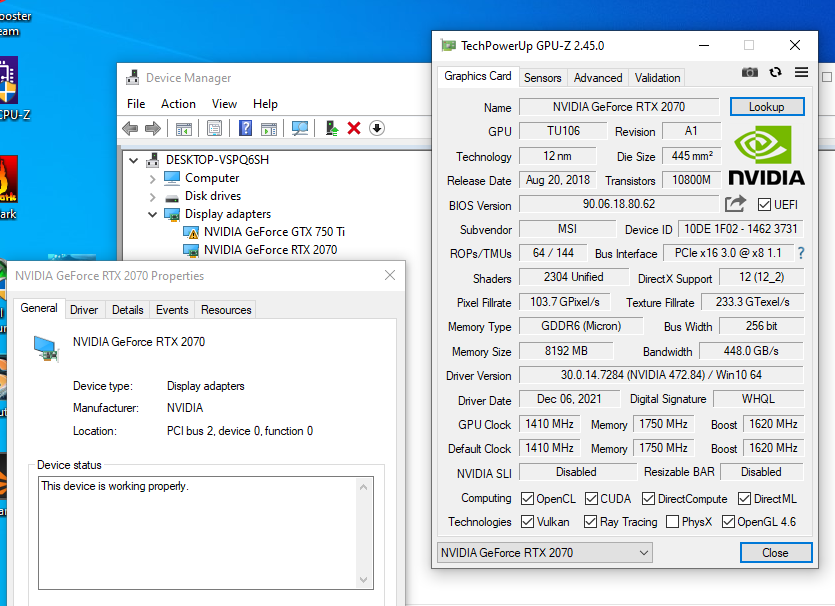Seller’s Note “Card does not allow the system to boot, goes to code 99 for 30 seconds and just restarts and does this is a loop”
Summary
- Resistances
- Vcore – 0.6Ω
- Vmem – 71.3Ω
- PEX – 14.2Ω
- 1.8V – 3.95KΩ
- 5V – 922Ω
- 3.3V – 535KΩ
- 12V – 58KΩ (slot) 1MΩ (8pin ext)
- voltages (all were in range)
- The card wont POST as a primary card (or rather probably does POST, but wont display), but was detected as a second.
- It also has a misconfigured BIOS shown in TPU (see picture)
Here we can see the suspicious BIOS values (GPU Clock, Memory seem much too low, not sure why)

Since the card is basically stable as a second card (without a picture), we can use nvflash https://www.techpowerup.com/download/nvidia-nvflash/. Always save the original BIOS file just in case. I did this by clicking the save in GPU-Z, you can also use
nvflash64 --save original-bios.romThen, find a matching BIOS in the GPU-Z VGA BIOS database https://www.techpowerup.com/vgabios/?architecture=NVIDIA&manufacturer=MSI&model=RTX+2070&interface=&memType=&memSize=&since=

I picked the newest of the two Ventus versions, since a quick look at the details confirmed all other values are the same between the two choices.
Next, open a cmd prompt in Administrator mode and navigate to where the nvflash executable is downloaded. When flashing the BIOS, two things to note:
- In this case, we have two cards, so be careful to select the secondary card using the index parameter
-i1(-i0is primary) - Initially, I forgot the
-6param to override write protection (shown below), necessary because we are changing BIOS version
C:\gputesting\nvflash_5.735>nvflash64.exe -i1 MSI.RTX2070.8192.181128.rom
NVIDIA Firmware Update Utility (Version 5.735.0)
Copyright (C) 1993-2021, NVIDIA Corporation. All rights reserved.
Checking for matches between display adapter(s) and image(s)...
WARNING: Firmware image PCI Subsystem ID (1462.3731)
does not match adapter PCI Subsystem ID (1462.3757).
NOTE: Exception caught.
Nothing changed!
ERROR: PCI subsystem ID mismatch
C:\gputesting\nvflash_5.735>nvflash64.exe -i1 -6 MSI.RTX2070.8192.181128.rom
NVIDIA Firmware Update Utility (Version 5.735.0)
Copyright (C) 1993-2021, NVIDIA Corporation. All rights reserved.
Checking for matches between display adapter(s) and image(s)...
WARNING: Firmware image PCI Subsystem ID (1462.3731)
does not match adapter PCI Subsystem ID (1462.3757).
You are intending to override PCI Subsystem ID.
Are you sure you want to continue?
Press 'y' to confirm (any other key to abort): y
Overriding the PCI Subsystem ID mismatch.
Current - Version:90.06.18.C0.83 ID:10DE:1F02:1462:3757
GPU Board (Normal Board)
Replace with - Version:90.06.18.80.62 ID:10DE:1F02:1462:3731
GPU Board (Normal Board)
Update display adapter firmware?
Press 'y' to confirm (any other key to abort):
[==================================================] 100 %
A reboot is required for the update to take effect.After a reboot, still running as a second card, the BIOS is looking a lot better and outputs a picture!

Additional learning, motherboard chipset and graphics card compatibility..
For a lot of PC setups, this could be fixed. However, in my particular PC setup (Z270 motherboard chipset), I had an additional learning that it doesn’t seem to initialise 20 series cards (this being the first I have tested/fixed) and as a result, the 2070 was only working as secondary card. I would guess this is because windows is able to detect the card, but my BIOS cant, resulting in a blank screen on boot. Linux thank fully gave me a hint, as Ubuntu displays an ‘Unknown chipset’ error when testing the card. Testing as a primary card using my modern X570 main PC works fine! 🙂
Update 12/12/2022 – Checking PCI lanes…
I was all set to sell this card after enjoying using it in my main PC. However, testing it on other motherboards failed to detect the card, even a modern one! Many months later, I thought that the common issue could possibly be intel motherboards failing and AMD ones passing (my main PC is AMD). So, I thought it might be worth checking the PCI lanes, as I have heard that some cards detect on AMD motherboards despite a PCI lane issue.
TODO measurements
Update 27/12/2022 – More testing
I checked out the data lanes and they mostly seem OK:
- Caps all about 200nF
- Transmitter lanes (front) – ALL show 0.960V diode mode
- Receiver lanes (back) resistance at core side of caps – most are ~80KΩ, lane 1 (not 0) both measure a bit lower at 74KΩ and lane 3 a bit higher at 87KΩ
In terms of detection, it seems that this card might actually always be detected, just not showing a picture? So:
- On my Z270 chipset motherboard, if the card is used as primary then no picture will be displayed during BIOS, but will display as soon as the drivers load.
- From memory, my X570 main PC did show a BIOS screen with the only strange thing being the fans would momentarily surge.
- On another test PC (more recent intel), the card never displays. It might, if the drivers were preinstalled, but it isn’t easy to test this as there are limited PCI slots, no internal IGPU and limited power supply PCI-E leads.
- I should try it in my son’s PC when I get a chance.
Puzzling condition, and certainly cannot be sold as working in this state. It might be the BIOS chip still cannot be read reliably by all motherboard chipsets.